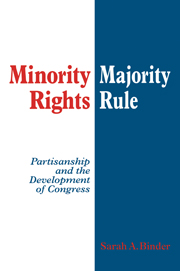Book contents
- Frontmatter
- Contents
- List of tables and figures
- Preface
- 1 The partisan basis of procedural choice
- 2 The evolving concepts of House and Senate minority rights
- 3 Procedural choice in the early Congress: The case of the “previous question”
- 4 Allocating minority rights in the House, 1789–1990
- 5 Institutionalizing party in the nineteenth-century House
- 6 Stacking the partisan deck in the twentieth-century House
- 7 Inherited rules and procedural choice in the Senate
- 8 Assessing the partisan theory
- Appendix 1 Summary of changes in minority rights
- Appendix 2 Measuring congressional workload
- Appendix 3 Measuring party behavior
- Bibliography
- Index
6 - Stacking the partisan deck in the twentieth-century House
Published online by Cambridge University Press: 10 December 2009
- Frontmatter
- Contents
- List of tables and figures
- Preface
- 1 The partisan basis of procedural choice
- 2 The evolving concepts of House and Senate minority rights
- 3 Procedural choice in the early Congress: The case of the “previous question”
- 4 Allocating minority rights in the House, 1789–1990
- 5 Institutionalizing party in the nineteenth-century House
- 6 Stacking the partisan deck in the twentieth-century House
- 7 Inherited rules and procedural choice in the Senate
- 8 Assessing the partisan theory
- Appendix 1 Summary of changes in minority rights
- Appendix 2 Measuring congressional workload
- Appendix 3 Measuring party behavior
- Bibliography
- Index
Summary
In the nineteenth-century House, the fate of minority rights was contingent on the strength of partisan coalitions and the nature of inherited rules. Provoked by obstructive minorities, strong majority parties gradually overcame procedural obstacles and altered House rules to lodge power over both policy and procedure in their party's hands. By the end of the nineteenth century, the role of party had been institutionalized in House rules – granting the majority party almost unfettered power to structure the agenda and manage floor debate and amending activity. As suggested in Chapter 4, however, the rights of the minority continued to evolve well after the advent of Reedism at the close of the nineteenth century. Indeed, the statistical evidence in that chapter suggests that majority parties in the twentieth century have continued to respond to periodic challenges to their control of the agenda. Charting the shape of those challenges, as well as the pattern of majority response, are my tasks in this chapter.
Immediately puzzling is why majority parties would continue to seek limits on minority rights well after party control had taken root in the House. From the perspective of House Republicans – who spent forty years in the minority in the modern Congress – restrictive rules changes were simply muscle-flexing by an arrogant Democratic majority, unaccustomed to life in the minority. But, as shown in Chapter 4, expected change in party control has little effect on the status of minority rights in the House.
- Type
- Chapter
- Information
- Minority Rights, Majority RulePartisanship and the Development of Congress, pp. 132 - 166Publisher: Cambridge University PressPrint publication year: 1997



